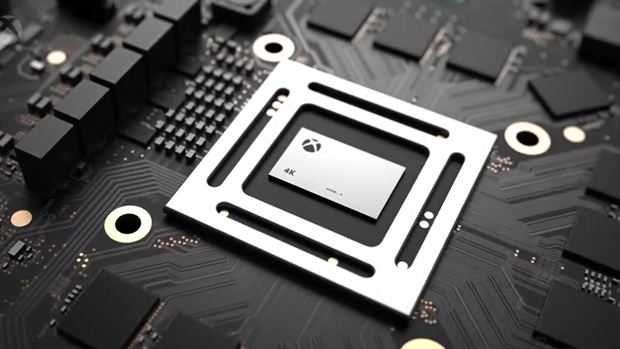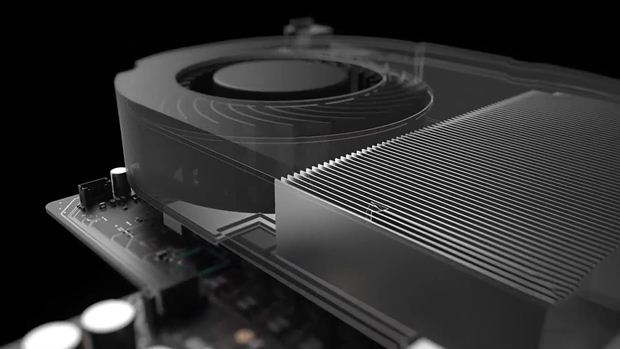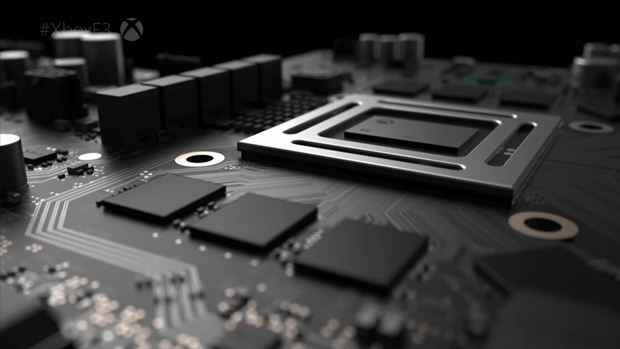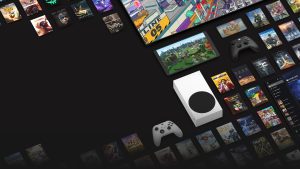
It’s surprising, really, just how fast time flies. We’ve now been talking about the PS4 Pro, Xbox Scorpio, and the Nintendo Switch for months. The Pro’s already out in the market, delivering largely what we expected it would: a compromised, sub-4K experience at an accessible price-point. As we discussed earlier, the Switch falls flat when it comes to pricing, stuffing old, mobile parts into a tablet form-factor, then selling that at a price that’s higher what the PS4 is currently available for. The Switch is due for a March 3rd release, but apart from the improbable miracle of it somehow not pouring Nintendo’s thirty-year-old hardware ambitions down the drain, it holds few surprises. With a whole extra year to take advantage of changes in the hardware market, it now falls on the Xbox Scorpio to drive console gaming forward over this (half) generation.
Note: Please note that this feature is a theory and opinion based on current technological trends. The only things we know for sure about the Scorpio is its 6TFLOPs GPU, 8 Core CPU and high bandwidth memory.
The rumour mill’s long had it that the Scorpio would make use of AMD’s latest, in terms of its graphics and processing components. The fact that Sony made use of Polaris in the Pro, just months after AMD outed the Polaris platform, indicates that the Pro’s specifications weren’t locked down early. This runs contrary to Nintendo’s rumored approach to the Switch, where it opted for the mature, Tegra X1 SoC, over the much newer and more powerful X2. Sony’s willingness to wait before finalizing on the Pro’s hardware spec gives us a degree of confidence about Microsoft’s hardware decisions with regards to the Scorpio.
While raw compute ability in teraflops isn’t an ideal measure for in-game performance Microsoft’s 6-teraflop claim for the Xbox Scorpio’s GPU limits hardware choices: Polaris 10 at stock clocks, a la the RX 480, can hit 5.6 teraflops, while the much older Hawaii platform, as seen in the 390X, can manage 5.9 teraflops. This possibly eliminates the chance of Microsoft using Polaris entirely. While Hawaii could (theoretically) hit the Scorpio’s performance envelope, it’s a three-year-old platform that runs hot and consumes far more power than would be viable for a console. Moreover, production of Hawaii parts was wound down months ago. This possibly leads to the conclusion that the Scorpio will make use of a Vega GPU, likely with a significant underclock to keep it within power and thermal limits.
Keeping Microsoft’s 6-teraflop performance envelop in mind, Vega is a near-certainty as far as the Scorpio’s graphics component is concerned. But what of the Scorpio’s CPU? It was initially assumed that the Scorpio would make use of an eight-core Jaguar configuration, possibly with a clockspeed bump like the PS4 Pro. It’s easy enough to see why: If the aim is to run Xbox One games at higher resolutions, and not to provide completely new experiences, additional CPU power isn’t really necessary. However, there are two possibilities for why Microsoft may opt for a real CPU upgrade. First off, when Microsoft initially took the wraps off the Scorpio at E3, it mentioned that the console will have an “eight-core processor.” Now, if a processor upgrade was completely off the table, there’d have been no reason for Microsoft to not dive into specifics.
On the other hand, the fact that they’ve left it essentially a blank slate implies that the eight-core processor in question doesn’t necessary have to use Jaguar cores. Again, if the aim is to offer Xbox One experiences, scaled up to 4K, there’s no need for a processor upgrade. However, Microsoft’s made it clear that Scorpio will offer exclusive VR experiences that will not be possible on older hardware. This is where additional CPU power becomes crucial: high, consistent framerates are essential in VR as lurching motion can cause people to feel nauseous. VR titles have to consistently hit 60 FPS or higher.
Commercial VR headsets like the HTC Vive and Oculus Rift actually have a 90 Hz refresh rate. In GPU-intensive titles, poor processing power isn’t much of a hindrance at typical framerates: you can reliably hit 30 FPS and above, even with modest kit like the Core i3-4130, provided you have enough GPU grunt. The problem arises when you’re trying to hit substantially higher framerates. Because the processor has to make draw calls to the GPU, a CPU bottleneck will arise if the processor is unable to the feed the GPU fast enough. The higher the framerate, the faster this has to take place. As far as contemporary AAA titles are concerned, you really do need something as powerful as a Core i5 to allow your GPU to hit VR-ready framerates.
Microsoft’s been cozying up to Oculus, with the Rift actually able to run Xbox One games in a virtual theater mode. If the Scorpio’s to be able to run Oculus titles, it will need significantly higher processing power. Microsoft could make this happen if they decide to incorporate a Ryzen CPU in the Scorpio. We’d reported earlier that a Scorpio presentation slide had apparently featured at AMD’s CES booth this year, where the emphasis was otherwise on Ryzen. The problem here is with costing and the way Ryzen is implemented. Because they’ve not been able to compete with Intel on IPC, AMD’s plan, til date, was to offer more processor cores, for cheaper. This made parts like the FX-8320 particularly well-suited for heavily multithreaded applications live video decoding and image processing.
However, PC games continued to lean heavily on single-threaded performance, meaning that AMD’s eight-core designs tended to lose out to dual and quad core i3’s and i5’s in games, even with sky-high overclocks. With Ryzen, the focus has been on improving IPC, with AMD claiming a 40 percent performance uplift per-clock, compared to Piledriver. But the economics here make eight-core Ryzen designs substantially more expensive. AMD’s own benchmarks pitted an eight-core Ryzen CPU against Intel’s 6950X, a $1500 processor.
While we expect Ryzen to come at more reasonable pricepoints, it’s hard to see a circa-$500 dollar console like the Scorpio packing an eight-core Ryzen processor, when flagship Ryzen SKUs could retail in the vicinity of $500 all by themselves. Nevertheless, prices aren’t set in stone and it wouldn’t be inconceivable that Microsoft makes use of a custom design with repurposed, low profile, mobile-oriented Ryzen cores, as they’ve done with Jaguar and the Xbox One.
Coming to pricing, it’s a tough call to see where exactly Microsoft will position the Scorpio in terms of price. They’ve repeatedly referred to Scorpio as a premium console. This implies that the Scorpio will launch at a higher price compared to the PS4 Pro. Just how much higher is dependent on two factors: differentiation and component costs.
Just how different the Xbox Scorpio experience is, compared to the Pro, will have a major impact on the kind of price point Microsoft sets. While the vanilla PS4 is Sony’s fastest-selling console to date, consumer response to the PS4 Pro has remained relatively tepid. Many people continue to game on 1080p displays and, apart from the moderate resolution bump, the Pro offers few others bells and whistles in most games, compared to the vanilla PS4. Apart from the bump up to 1440p or checkerboard rendering, there’s simply not much that differentiates the Pro or gives most people a reason to buy it over the now-cheaper PS4.
How would the Xbox Scorpio fit in this scenario? Microsoft themselves have stated that their plans for Scorpio are broadly similar to what Sony’s doing with the Pro: they want to offer a halfway house console that will run current-gen games at higher resolutions. But if native 4K/30 output is the only thing that sets the Scorpio apart from the PS4 Pro, there might might not be too many takers for the Scorpio if it launches at a higher price-point, around $500.
Microsoft’s statement on VR and Scorpio exclusivity are a positive sign: it means that, unlike Sony, they’re not entirely averse to the idea of some kind of Scorpio exclusivity. If this trickles down to regular Scorpio games, then Microsoft would have a bankable reason to sell the Scorpio at a price premium: this would be particularly compelling if the Scorpio receives a processor upgrade that allows for deeper, simulation and systems-based gameplay than is possible on current consoles. While Microsoft’s current line is that there won’t be exclusives, Microsoft has a history of backtracking on Xbox features, if the Xbox One’s always-online debacle is anything to go by. Scorpio exclusives, even if they’re just a handful, would give consumers a real reason to buy Scorpio over the Pro or a midrange PC.
Component costs play just as important a role in determining Scorpio’s pricing. Vega 10 is AMD’s flagship 2017 GPU. The full-fat PC iteration of Vega 10 goes head-to-head with Nvidia’s Titan X. This is a GPU that’s capable of delivering ludicrously powerful flagship experiences. Sourcing a Vega 10 GPU, even partially-enabled one, will not be cheap. While the mainstream Vega 11 platform might offer the right kind of performance for the Scorpio, Vega 11 parts are even further off in the horizon.
If a cut-down Vega 10 GPU is at the heart of the Scorpio, this significantly raises the minimum threshold for the Scorpio’s price. If, in addition to this, the Scorpio features a Ryzen CPU, we’re talking about a price-point that’s well in excess of $500. That’s not an unheard price for consoles in general: after all, the PS3 60 GB launched at $599 back in 2006.
But the higher the price set for the Scorpio, the more it will need to differentiate itself from the competition: by the time the Scorpio releases, the PS4 Pro will likely be a $349 box that offers a passable “4K” experience. If more developers start incorporating 1080p “bells-and-whistles” modes, it might actually turn into a viable alternative for premium 1080p gaming, compared to midrange PCs. If all the Scorpio offers at that point is a marginally higher resolution, people might not be willing to buy it at a premium price-point. If the Scorpio wants to succeed on the market with a high sticker price, it needs differentiators, and the most straightforward way of achieving that would be to have Scorpio exclusives. What Microsoft has to say about that remains to be seen.
All in all, 2017 is shaping up to be a very interesting year indeed for gaming. VR is likely to slip further into the mainstream. Pricing apart, the Switch offers a real console experience on the go, and the PS4 Pro brings eighth-gen console visuals more in line with the contemporary PC baseline. The Scorpio’s launching in a dynamic market. How capable it is, and how sensibly its priced, have everything to do with how it’ll fare.

















